- Prosaro is the ideal fungicide for wheat controlling all of the main diseases - Septoria leaf blotch, stripe rust, leaf rust and ear diseases. Together with VIMOY iblon, Prosaro allows fungicide programmes to be devised for all wheat crops.
- Prosaro is an easy-to-use, ready mixed fungicide containing two different DMI fungicides. These are combined in the ideal ratio to help slow down the development of Septoria tritici intolerance to DMI fungicides.
- Prosaro is very convenient with just one dose rate for use on all wheat varieties.

- Home
- Products
- Fungicides
- Prosaro

Prosaro
Prosaro - the dual DMI fungicide for broad spectrum disease control in wheat, barley and ryegrass seed crops.
-
Benefits
-
Crop Suitability & Usage
-
Resources
| Crop | Diseases Controlled |
|---|---|
| Wheat | Septoria tritici, stripe rust, leaf rust, powdery mildew, glume-blotch, ear disease complex |
| Barley | Scald, net blotch, spot blotch, ramularia leaf spot, leaf rust, ear disease complex |
| Ryegrass Seed Crops | Crown rust, stem rust, blind seed disease |
| Product Type | Fungicide |
| Active Ingredient | Prothioconazole 125 g/l Tebuconazole 125 g/l |
| Formulation Type | Emulsifiable concentrate |
| Pack Size | 10L |
| Application Rate/Timing | Wheat Diseases: Septoria tritici, Stripe Rust, Leaf rust, Powdery mildew, Glume-blotch, Ear disease complex Apply 1.0 L/ha on the first sign of disease. Should disease pressure persist or reinfection occurs, a further application may be required 3 - 4 weeks later. To control ear disease complex apply to fully emerged ears. Apply in at least 200 L of water per hectare by ground or in 50 L of water per hectare when aerially applied. Use high water volumes in dense or advanced crops especially under dry weather conditions Barley Diseases: Scald, Net blotch, Spot blotch, Ramularia leaf spot, Leaf rust, Ear disease complex Apply 1.0 L/ha on the first sign of disease. Should disease pressure persist or reinfection occurs, a further application may be required 3 - 4 weeks later. To control ear disease complex apply to fully emerged ears. Apply in at least 200 L of water per hectare by ground or in 50 L water per hectare when aerially applied. Use high water volumes in dense or advanced crops especially under dry weather conditions. Ryegrass Seed Crops Diseases: Crown rust, Stem rust, Blind seed disease Apply 1.0 L/ha on the first sign of disease. Should disease pressure persist or reinfection occurs, a further application may be required 3 - 4 weeks later. To control blind disease apply at the start of flowering with a second application 10 - 14 days later. Apply in at least 200 L of water per hectare by ground or in 50 L of water per hectare if aerially applied. Use high water volumes in dense or advanced crops especially under dry weather conditions. |
| Withholding Period | Cereals (grain): 56 days Cereals (forage): 42 days Ryegrass (seed): 30 days Ryegrass (forage): 35 days |
| Compatibility | Prosaro is compatible with commonly-used herbicides and insecticides. |
| Mixing | Half fill the spray tank with water, then pour in the required quantity of Prosaro® with agitators running, then top up with water. Do not pre-mix. |
No results for this category. Please select a different one.

Prosaro Label

Prosaro SDS

Prosaro HazNote

VIMOY iblon + Prosaro User Guide 2021

VIMOY iblon + Prosaro iGuide

VIMOY iblon + Prosaro iGuide for Barley

VIMOY iblon + Prosaro iGuide for Wheat

Cereal Disease iGuide
Latest Prosaro news
Related Pests
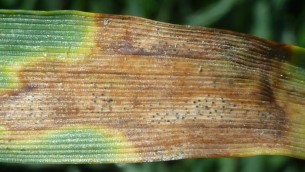
Septoria Leaf Blotch
Mycosphaerella graminicola
Speckled leaf blotch (also known as septoria tritici and septoria leaf blotch) has recently become a common disease of wheat which can result in significant yield loss if not controlled. The main
source of infection is spores from infected crop debris with first infections taking place from March to May. Following infection the fungus develops within the leaf until sporulating lesions appear. The key identification feature during winter is the presence of black pycnidia. Later in the year the lesions also tend to become stripe like. The disease undergoes multiple cycles within a crop.
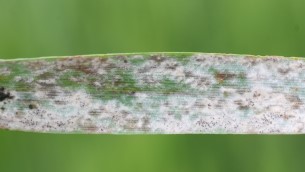
Powdery Mildew - Wheat
Blumeria graminis
Powdery mildew is a common parasitic fungus of wheat. Powdery mildew produces white, fluffy mycelial growth, usually on the leaves but also on the stems and ears and as the disease
only infects the outer plant layers it can be scraped off quite easily. Powdery mildew needs to infect living plant material to survive and so wind borne spores from volunteer plants are the likely source of inoculum. Serious disease infections can lead to significant yield losses.
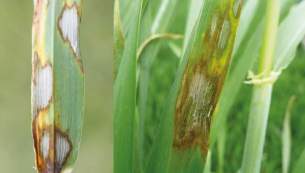
Scald
Rhynchosporium secalis
Scald (Rhynchosporium secalis) is a common disease of barley which can result in significant yield loss if not controlled. Scald is favoured by cooler, moist conditions with the initial source of inoculum being infected straw
debris. The first symptoms often appear during winter or early spring, initially as pale greyish lesions which then develop a more straw coloured appearance with a defined dark edge to the lesion.
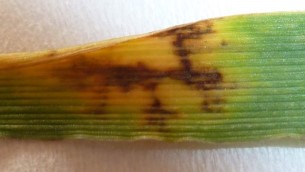
Net Blotch
Pyreophora teres
Net blotch (Pyreophora teres) is a common disease of autumn sown barley (much less commonly spring sown barley) which can result in significant yield loss if not controlled. Charateristics net type lesions
give the disease its common name but lesions can also take the form of dark stripes and streaks and when infection is severe in large dead areas of leaf. Infection sources are either seed or crop debris, which is borne out by second year barley crops being likely to carry infection. Net blotch development is favoured by cool, moist conditions.
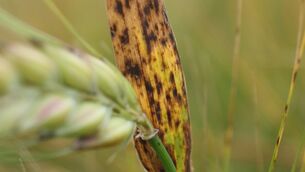
Ramularia Leaf Spot
Ramularia collo-cygni
Ramularia leaf spot (Ramularia collo-cygni) is a common disease of barley which can result in significant yield loss if not controlled. While both winter and spring planted barley can be affected, the impact of Ramularia is
usually greater on winter planted crops. Ramularia is seed borne and once the fungus has infected the plant it grows within the plant, not producing visible symptoms until around ear emergence. Symptoms consist of small brown lesions which under the right conditions can rapidly increase and coalesce together.
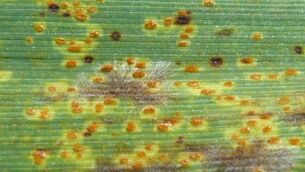
Leaf Rust - Barley
Puccinia hordei
Leaf rust (also known as brown rust) is a disease of barley. Whilst occurring less frequently than leaf rust in wheat it can result in significant yield loss if not controlled. Leaf rust is favoured by
warmer, drier conditions with the initial source of inoculum being infected volunteer cereals. Under favourable conditions leaf rust can develop very quickly. Spores are scattered at random on the leaf and are often surrounded by a pale chlorotic halo.
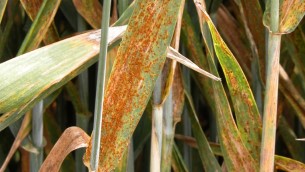
Leaf Rust - Wheat
Puccinia triticina
Leaf rust (also known as brown rust) is a common disease of wheat which can result in significant yield loss if not controlled. Leaf rust is favoured by warmer, drier conditions with the initial
source of inoculum being infected volunteer cereals. Under favourable conditions leaf rust can develop very quickly. Spores are scattered at random on the leaf and are often surrounded by a pale chlorotic halo.
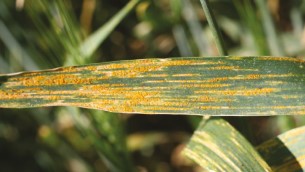
Stripe Rust - Wheat
Puccinia striiformis
Stripe rust (Puccinia striiformis) also known as yellow rust, is a common disease of wheat which can result in significant yield loss if not controlled. Stripe rust is favoured by cooler, moist conditions with the initial
source of inoculum being infected volunteer cereals. Under favourable conditions stripe rust can develop very quickly forming disease foci surrounding the initial infection source. At first spores tend to be scattered on the leaf but on more mature leaves they show the typical stripe arrangement which gives the fungus its common name. Occasionally stripe rust can infect the ear.






